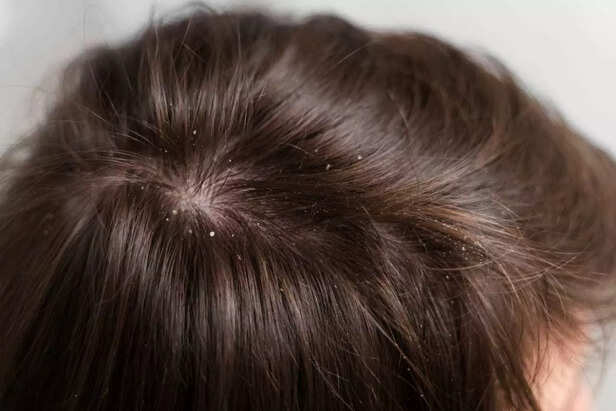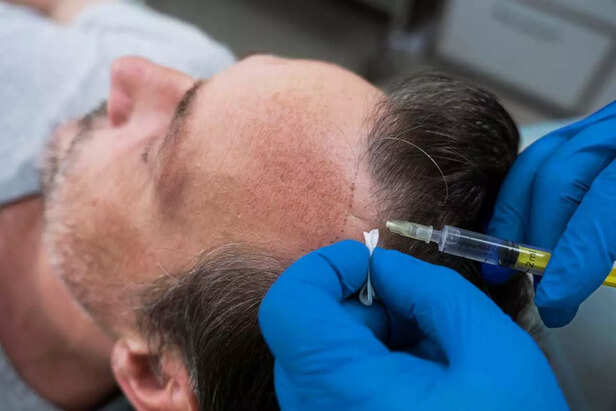Why Your Hair Falls Every Winter — And How to Stop It for Good
Siddhartha Gupta | Tue, 28 Oct 2025
Every year, as India shifts from monsoon to winter, millions suddenly notice their hairbrush filling up — a silent epidemic called seasonal hair fall. Dermatologists call it Telogen Effluvium — a natural hair-shedding phase triggered by stress, water quality, and nutritional changes. But beyond biology, our modern lifestyle, polluted air, and quick-fix routines are making it worse. This story unpacks the real science, expert insights, and simple dermatological, Ayurvedic, and home remedies to help you reclaim your hair — and your peace of mind.
Hairfall Problem
( Image credit : Freepik )
Every October, as the weather cools and the festive season begins, countless Indians face the same horror — handfuls of hair after a shower. This collective anxiety is so common that dermatologists now call it “The Great Indian Hair Fall Season.” From Mumbai’s humidity to Delhi’s dry chill, something about the post-monsoon and early winter transition wreaks havoc on our hair. But why?
The Science: Understanding the
 To understand this phenomenon, we need to decode the hair growth cycle. Each hair strand on your scalp goes through three phases:
To understand this phenomenon, we need to decode the hair growth cycle. Each hair strand on your scalp goes through three phases:
According to a dermatologist, “Seasonal shedding is a physiological event. During post-monsoon months, humidity drops and scalp health changes. Your hair roots enter a rest mode, leading to temporary but visible shedding.”
The good news? It’s reversible.
There’s a reason your hair feels thinner in October or November. India’s climatic rhythm plays a huge role.
Humidity Drop: After months of moisture, the sudden dry air of winter makes the scalp dehydrated, leading to brittle strands and weaker roots.
Pollution Spike: Post-Diwali smog and increased dust levels clog hair follicles and inflame the scalp.
Water Quality: As municipal water sources shift, mineral-heavy “hard water” during winter increases calcium and magnesium build-up — weakening hair shafts.
Stress and Sleep: Festive deadlines, late nights, and travel impact hormonal balance — raising cortisol levels, which are directly linked to hair loss.
Nutritional Dips: Festive indulgence often replaces protein- and iron-rich meals with sweets and snacks, creating micro-nutrient deficiencies.
So, it’s not “just the weather.” It’s your entire ecosystem changing.
Even when the climate is blamed, dermatologists say there are silent villains behind the scenes:
 Step 1: Diagnosis Matters.
Step 1: Diagnosis Matters.
A trichologist says, “If you’re losing over 100 strands a day for more than six weeks, it’s time to visit a dermatologist. Don’t rely only on home remedies — rule out iron, vitamin D, and thyroid deficiencies first.”
Step 2: Treat the Scalp, Not Just the Hair.
Most hair problems begin in the scalp. Dermatologists recommend gentle exfoliation once a week using salicylic acid-based scalp serums to remove build-up.
Step 3: Focus on Nutrition.
Hair is made of keratin, a protein. Without enough dietary protein, hair growth halts. Experts suggest:
For chronic cases, dermatologists prescribe minoxidil-based serums or platelet-rich plasma therapy to stimulate dormant follicles.
According to Ayurveda, hair fall is linked to an imbalance of Pitta dosha, aggravated by heat, stress, and irregular routines. The goal is to restore scalp harmony through cooling, nourishing therapies.
Bhringraj Oil: Known as “the king of herbs for hair,” it strengthens roots and promotes growth.
Amla and Brahmi: Reduce Pitta and nourish follicles.
Neem Oil: Detoxifies scalp and controls dandruff.
Nasya Therapy: Applying herbal oil drops in the nostrils helps balance hormones and reduce stress.
Dietary Tips: Avoid excessive spicy and fried foods; add coconut water, ghee, and leafy greens.
 While grandma’s remedies may sound old-school, many are scientifically backed. Here are expert-approved home solutions:
While grandma’s remedies may sound old-school, many are scientifically backed. Here are expert-approved home solutions:
Hair fall is not just about follicles — it’s about feelings. Chronic stress pushes hair prematurely into the Telogen phase. Insomnia, anxiety, and emotional fatigue are now major hair loss accelerators.
A dermatologist says, “Your hair mirrors your lifestyle. If you’re mentally exhausted, your hair will show it first.”
Solutions:
 India’s urban population faces a unique hair crisis — environmental damage. Hard water, chlorine, and air pollutants weaken hair from the outside in.
India’s urban population faces a unique hair crisis — environmental damage. Hard water, chlorine, and air pollutants weaken hair from the outside in.
Hair health is a mirror of what’s happening inside your body. Crash diets, skipping meals, and festive bingeing all show up on your scalp.
Key nutrients your hair loves:
Your hair is the barometer of your body’s balance. Whether it’s Telogen Effluvium, poor diet, or emotional fatigue — it’s all connected. The goal isn’t just to stop hair fall, but to rebuild resilience — of your scalp, your lifestyle, and your self-belief.
In the end, remember: healthy hair is not grown, it’s nurtured — through patience, balance, and awareness.
And that’s how you outsmart the Great Indian Hair Fall Season — not with fear, but with knowledge.
Unlock insightful tips and inspiration on personal growth, productivity, and well-being. Stay motivated and updated with the latest at My Life XP.
The Science: Understanding the Telogen Effluvium Phase

Science behind hairfall
( Image credit : Freepik )
- Anagen (Growth Phase): Lasts 2–6 years. About 85–90% of your hair is here.
- Catagen (Transition Phase): Lasts 1–2 weeks. Hair stops growing and prepares to shed.
- Telogen (Resting Phase): Lasts 2–3 months. The hair “rests” before it naturally falls and regrows.
According to a dermatologist, “Seasonal shedding is a physiological event. During post-monsoon months, humidity drops and scalp health changes. Your hair roots enter a rest mode, leading to temporary but visible shedding.”
The good news? It’s reversible.
Why It Peaks After Monsoon and Before Winter
Humidity Drop: After months of moisture, the sudden dry air of winter makes the scalp dehydrated, leading to brittle strands and weaker roots.
Pollution Spike: Post-Diwali smog and increased dust levels clog hair follicles and inflame the scalp.
Water Quality: As municipal water sources shift, mineral-heavy “hard water” during winter increases calcium and magnesium build-up — weakening hair shafts.
Stress and Sleep: Festive deadlines, late nights, and travel impact hormonal balance — raising cortisol levels, which are directly linked to hair loss.
Nutritional Dips: Festive indulgence often replaces protein- and iron-rich meals with sweets and snacks, creating micro-nutrient deficiencies.
So, it’s not “just the weather.” It’s your entire ecosystem changing.
Hidden Triggers We Don’t Notice
- Hot Showers: Overly hot water strips natural oils, making roots weak.
- Wrong Shampoos: Sulfate-heavy shampoos dry out the scalp and worsen shedding.
- Frequent Styling: Hair dryers and straighteners damage keratin bonds.
- Tight Hairstyles: Constant pulling leads to traction alopecia.
- Hard Water and Chlorine: Common in urban India, both interfere with scalp pH.
- PCOS and Thyroid Disorders: Both increasingly common among Indian women, these hormonal imbalances worsen Telogen Effluvium.
What Dermatologists Recommend

Dermatologist recommendation for hair fall
( Image credit : Freepik )
A trichologist says, “If you’re losing over 100 strands a day for more than six weeks, it’s time to visit a dermatologist. Don’t rely only on home remedies — rule out iron, vitamin D, and thyroid deficiencies first.”
Step 2: Treat the Scalp, Not Just the Hair.
Most hair problems begin in the scalp. Dermatologists recommend gentle exfoliation once a week using salicylic acid-based scalp serums to remove build-up.
Step 3: Focus on Nutrition.
Hair is made of keratin, a protein. Without enough dietary protein, hair growth halts. Experts suggest:
- Include eggs, paneer, lentils, and nuts daily.
- Add biotin-rich foods like almonds, spinach, and mushrooms.
- Take supplements only after medical advice.
For chronic cases, dermatologists prescribe minoxidil-based serums or platelet-rich plasma therapy to stimulate dormant follicles.
Ayurvedic Perspective: Balancing Doshas for Hair Harmony
Ayurvedic Solutions:
Amla and Brahmi: Reduce Pitta and nourish follicles.
Neem Oil: Detoxifies scalp and controls dandruff.
Nasya Therapy: Applying herbal oil drops in the nostrils helps balance hormones and reduce stress.
Dietary Tips: Avoid excessive spicy and fried foods; add coconut water, ghee, and leafy greens.
Home Remedies That Actually Work

Home remedies for hairfall
( Image credit : Freepik )
- Onion Juice: Sulfur-rich, improves collagen production and boosts regrowth.
- Aloe Vera Gel: Hydrates scalp and reduces inflammation.
- Coconut Oil + Curry Leaves: Strengthens hair shafts and prevents breakage.
- Fenugreek (Methi) Seeds: Rich in protein and nicotinic acid — ideal for hair masks.
- Green Tea Rinse: Antioxidants improve scalp circulation.
Stress, Sleep, and the Mind-Body Connection
A dermatologist says, “Your hair mirrors your lifestyle. If you’re mentally exhausted, your hair will show it first.”
Solutions:
- Practice deep breathing or yoga nidra before bed.
- Sleep 7–8 hours daily — melatonin helps regulate hair growth cycles.
- Limit caffeine post-evening; increase hydration.
- When you calm your mind, your scalp follows.
Changing Water and Air: The Urban Challenge

Hair loss
( Image credit : Freepik )
- Use water softeners or shower filters in cities with hard water (Delhi, Pune, Hyderabad).
- Cover hair while commuting — dust and pollutants settle on the scalp.
- Wash hair within an hour of returning home from polluted areas.
- Use antioxidant serums with niacinamide or green tea extracts.
Nutrition — The Forgotten Pillar
Key nutrients your hair loves:
- Iron: Spinach, beets, and lentils.
- Protein: Eggs, paneer, soy, and quinoa.
- Zinc: Pumpkin seeds, peanuts, chickpeas.
- Omega-3: Flaxseeds, walnuts, fish.
- Vitamin D: Early morning sunlight and fortified milk.
It’s Not Just Hair, It’s Health
In the end, remember: healthy hair is not grown, it’s nurtured — through patience, balance, and awareness.
And that’s how you outsmart the Great Indian Hair Fall Season — not with fear, but with knowledge.
Unlock insightful tips and inspiration on personal growth, productivity, and well-being. Stay motivated and updated with the latest at My Life XP.





